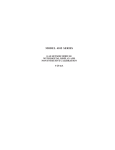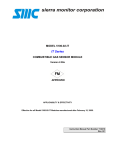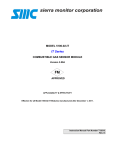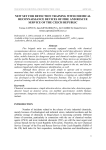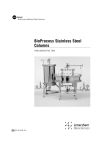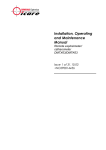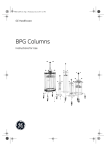Download Sierra Monitor Corporation SENTRY 5000 User's Manual
Transcript
MODEL 5000 SENTRY GAS MONITORING SYSTEM Version 6 Sensors Service APPLICABILITY & EFFECTIVITY Effective for all Sentry systems manufactured after September 1, 1995. Instruction Manual Part Number T12001-A1 Sierra Monitor Corporation 1991 Tarob Court, Milpitas, CA 95035 (408) 262-6611 Applicability & Effectivity SMC sierra monitor corporation 7.5 Sentry Instruction Manual - Version 6 COMBUSTIBLE GAS SENSOR MODULE (5100-02) 7.5.1 DESCRIPTION The Combustible Gas Module includes the sensor and electronic assembly installed in an explosion proof housing. The sensor screws into one hub of the enclosure and plugs into the bottom electronics card via a six pin connector. Cabling to the controller connects to a three pin spring loaded terminal strip. 7.5.2 TROUBLE ANALYSIS Electrical adjustment, or replacement of the sensor will be necessary under the following conditions: • Controller displays the following error messages: CHK BRIDGE VOLT SENSOR FAILURE LOW SENSITIVITY • False readings or alarms are received due to sensor inaccuracy. Warning: : During sensor adjustments the concentration reading on the controller will be inaccurate and alarm level concentrations may be displayed. If false activation of the alarm relays will cause a problem disconnect the relay wiring prior to adjustment or turn the module off using the CHANGE MODULE mode. NOTE Although all the necessary data can be collected with a voltmeter at the sensor module, some helpful information can be displayed or printed. See diagnostic codes 0004 and 0008 in Appendix C. Figure 7-6 Cover Plate - Combustible Gas Module Comparing to the "GND" (ground) test point measure "BRIDGE VOL" (bridge voltage) and adjust to 2.00 VDC using "BRIDGE ADJ" potentiometer. Turn counterclockwise to increase. 7.5.3.2 ZERO ADJUSTMENT 7.5.3 ADJUSTMENT PROCEDURE Comparing to ground measure SIGNAL OUT and adjust to 0.18 VDC by turning ZERO ADJ potentiometer. Turn counter clock-wise to increase. Prior to reading voltages and making adjustments perform a visual inspection to confirm that there are no physical problems such as water in the electronics enclosure, wiring damage or corrosion. 7.5.3.3 SPAN ADJUSTMENT Use Figure 7-6 to locate test points during the following procedures: Caution: The area must be free of flammable vapors or gases during any adjustments or maintenance procedures. 7.5.3.1 BRIDGE VOLTAGE ADJUSTMENT Confirm that no combustible gas is present and remove sensor module cover. SERVICE Page: 69 1. Determine the concentration of the calibration gas (CG) in % LEL. 2. Use the following formula to determine the response to the calibration gas at SIGNAL OUT. Voltage (Signal Out) = (CG+12)/60 For Example: If CG = 50% L.E.L Signal Out = (50+12)/60 = 1.03 volts SMC sierra monitor corporation 3. 4. 5. Sentry Instruction Manual - Version 6 Using a Sierra Monitor Model 1200-26 Gas Calibrator with a Sierra Monitor Model 535800 calibration adapter, or Model 5360 Gas Delivery Fitting. Apply the calibration gas at a flow rate of 100 cc/min. until the signal out voltage stops changing (approx. 2 minutes). Then adjust span adj. potentiometer to the calculated value. PIN Remove the calibration gas and wait for the voltage to drop. If the voltage is below 0.30 VDC the procedure is complete. If the voltage is above 0.30 VDC repeat the zero and span adjustments. Calibrate the sensor using the instruction manual procedure. • A LOW SENSITIVITY message during calibration indicates one of the two conditions for a combustible sensor: • The zero gas voltage must be less than .3 volts. • The new span change (span voltage less zero voltage) must exceed 30% of the calculated span change. For Example: Zero gas voltage = .20 VDC Span voltage = .43 VDC Span change is .43-.2 = .23 VDC As the calculated span value (from step 5 above) is 1.03, the calculated span change is: 1.03-.2 = .87 By calculation: 30% of .87 = .26 The new span change (.23) is less than 30% of the calculated span change so a LOW SENSITIVITY message will be displayed. FUNCTION WIRE COLOR 1 DETECTOR WHITE 2 COMPENSATOR BROWN 3 CALIB. SW. RED 4 DETECTOR BLACK 5 DRAIN 6 CALIB. SW. BARE GREEN Table 7-5 Combustible Gas Sensor Wiring Pin Out 1. Detector element resistance should be between 1.5 to 2 ohms. 2. Compensator element resistance should be between 1.5 to 2 ohms. 3. Calibration switch should be open in normal operation and should close when the calibration magnet is applied. If the sensor fails any of these tests it should be replaced. If the sensor passes these tests the electronics are suspect and BOTH the sensor and electronics should be replaced. (The electronics and sensor which are removed should be returned to the factory for evaluation). When a new sensor is installed the following actions must be taken: The LOW SENSITIVITY calculation is made to insure that the calibration does not adjust the electronics so that the "gain" is large enough to cause false alarms due to minor drift or due to minimal electronic noise. 7.5.4 SENSOR REPLACEMENT If any of the above adjustments cannot be completed successfully the sensor and/or electronics will require replacement. To check the sensor unplug it from the electronics and remove from the housing so that continuity and resistance tests can be made. Table 7-4 provides the pin out for the sensor assembly. SERVICE Page: 70 • Make the bridge voltage adjustment immediately to avoid over-voltage damage to the sensor. • Use diagnostic code 0020 to establish nominal value calibration. • Allow 24 hours for full stabilization of the sensor, recheck the zero and span adjustments and calibrate the sensor module. SMC sierra monitor corporation Sentry Instruction Manual - Version 6 7.5.5 COMBUSTIBLE GAS SCALING FACTORS For combustible gas monitoring, a calibration standard of Methane or Propane my be used in conjunction with scaling factors to cause Sentry concentration display and alarm function in %LEL scale of another gas as follows: GAS Acetaldehyde Acetic Acid Acetic Anhydride Acetone Acetylene Alkyl Alcohol Ammonia n-Amyl Alcohol Aniline Benzene Biphenyl 1,3-Butadiene n-Butane iso-Butane Butene-1 cis-Butene-2 trans-Butene-2 n-Butyl Alcohol iso-Butyl Alcohol tert-Butyl-Alcohol n-Butyl Benzene iso-Butyl Benzene n-Butyric Acid Carbon Disulfide Carbon Monoxide Carbon Oxysulphide Chlorobenzene Cyanogen Cyclohexane Cyclopropane n-Decane Diethylamine Dimethylamine 2,3-Dimethylpentane 2,3-Dimethylpropane Dimethylsulphide 1,4-Dioxane Epichlorohydrin Ethane Ethyl Acetate Ethyl Alcohol Ethylamine Ethyl Benzene Ethyl Bromide Ethyl Chloride Ethylcyclopentane Ethylene Ethylenedichloride Ethyleneoxide METHANE FACTOR 60 54 46 52 57 51 126 33 39 41 25 56 58 52 45 48 51 34 53 74 31 32 38 18 75 93 34 89 41 62 33 49 58 40 40 43 45 45 68 51 73 53 36 91 57 40 71 66 52 PROPANE FACTOR 109 98 83 94 103 92 229 59 71 74 45 101 106 94 82 88 92 62 96 134 57 58 69 32 137 169 62 162 74 113 59 88 105 72 72 79 81 82 123 93 132 95 65 165 103 72 128 120 94 GAS Diethyl Ether Dimethoxyethane Dimethyl Ether Dimethylformamide Ethyl Formate Ethylmercaptan n-Heptane n-Hexane Hydrazine Hydrogencyanide Hydrogen Hydrogen Sulfide Methane Methyl Actetate Methyl Alcohol Methylamine Methyl Bromide Methyl Chloride Methylcyclohexane Methylenedichloride Methylethylether Methylethylketone Methyl Formate Methylmercaptan Methylpropionate Methyl n-propylketone Napthalene Nitromethane n-Nonane n-Octane n-Pentane i-Pentane Propane n-Propyl Alcohol n-Propylamine n-Propylchloride Propylene Propyleneoxide iso-Propylether Propyne Toluene Triethylamine Trimethylamine Vinylethylether o-Xylene m-Xylene p-Xylene JP-4 (Jet Fuel) METHANE FACTOR 46 42 63 46 44 56 39 37 45 48 77 41 100 50 86 77 90 102 44 93 44 41 67 61 51 40 34 34 31 37 46 46 55 47 48 50 52 46 44 42 40 40 48 42 36 39 39 41 PROPANE FACTOR 84 75 113 83 80 102 70 67 82 86 139 74 181 90 156 140 162 186 80 168 80 75 121 110 93 73 62 62 57 68 83 84 100 85 88 90 93 83 79 75 73 72 88 76 65 71 71 73 NOTES: 1. Scaling factors are not FMRC approved. 2. Base data source: EEV sensor specification catalog. (EEV claims some data is the result of specific tests, other data is empirically derived.) SERVICE Page: 71 SMC sierra monitor corporation Sentry Instruction Manual - Version 6 7.6 OXYGEN MODULE (5100-03) 7.6.1 DESCRIPTION The Oxygen Module includes the electronic assembly installed in an explosion proof housing and the electrochemical sensor connected to one hub of the enclosure. Cabling from the controller connects to a three pin spring loaded terminal strip. 7.6.2 TROUBLE ANALYSIS Electrical adjustment, or replacement of the sensor will be necessary under the following conditions: • Controller displays the following error messages: CHANGE SENSOR SENSOR FAILURE REPLACE SENSOR • False readings or alarms are received due to sensor inaccuracy. Warning: During sensor adjustments the concentration reading on the controller will be inaccurate and alarm level concentrations may be displayed. If false activation of the alarm relays will cause a problem disconnect the relay wiring prior to adjustment or turn the module off using the "Change Module" mode. Figure 7-7 Cover Plate - Oxygen Module 7.6.4 SENSOR REPLACEMENT NOTE Although all the necessary data can be collected with a voltmeter at the sensor module, some helpful information can be displayed on the controller or printed. See diagnostic codes 0004 and 0008 in Appendix C. The oxygen sensor should be replaced when it can no longer be calibrated correctly or when the signal output drops to zero. Generally this is every twelve to eighteen months. The Sentry clock keeps track of the age of the sensor if it is correctly initialized in the "change module" mode. 7.6.3 ADJUSTMENT PROCEDURE Prior to reading voltages and making adjustments perform a visual inspection to confirm that there are no physical problems such as water in the electronics enclosure, wiring damage or corrosion. Use Figure 7-7 to locate test points during the following procedures. 7.6.3.1 SIGNAL ADJUSTMENT It is unlikely that any electrical adjustment will be required except when a new sensor is installed. To make the electrical adjustment connect a voltmeter to SIGNAL OUT (pos) and GND (ground) and use SENSITIVITY ADJ potentiometer to set the voltage equal to 1/10 of the actual oxygen concentration. In clean air the concentration is 20.9% so the voltage should be set at 2.09 VDC. When a new sensor is installed use the CHANGE MODULE menu selection to answer yes to the "new sensor?" question. After nine months the CHANGE SENSOR message will be displayed to warn that a new sensor should be installed. The SENSOR FAILURE message for Oxygen sensors does not indicate a specific failure of the sensor but indicates that the sensor is not correctly connected to the electronics. If this message appears check that the sensor harness is correctly installed to the connector on the bottom electronics board. When sensor replacement is required, open the cover of the sensor module, remove the transmitter and disconnect the sensor wiring harness from the back of the transmitter. SERVICE Page: 72 SMC sierra monitor corporation Sentry Instruction Manual - Version 6 Unscrew the old sensor from the conduit hub, screw in the new sensor and connect the wiring harness to the transmitter electronics. Replace the transmitter into the enclosure, make signal adjustments as described above, and replace the enclosure cover. After the sensor is installed: • Update "new sensor" status in the change module mode. • Allow one hour of stabilization of the new sensor. • Make the electrical sensitivity adjustment as described above. • Calibrate the sensor module. SERVICE Page: 73 SMC sierra monitor corporation Sentry Instruction Manual - Version 6 7.7 CARBON MONOXIDE MODULE (5100-04) 7.7.1 DESCRIPTION The Carbon Monoxide Module includes the sensor and electronic assembly installed in an explosion proof housing. The sensor screws into one hub of the enclosure and plugs into the bottom electronics card via a six pin connector. Cabling from the controller connects to a three pin spring loaded terminal strip. 7.7.2 TROUBLE ANALYSIS Electrical adjustment, or replacement of the sensor will be necessary under the following conditions: • Controller displays the following error messages SENSOR FAILURE LOW SENSITIVITY • False readings or alarms are received due to sensor inaccuracy. Warning: During sensor adjustments the concentration reading on the controller will be inaccurate and alarm level concentrations may be displayed. If false activation of the alarm relays will cause a problem disconnect the relay wiring prior to adjustment or turn the module off using the "Change Module" mode. Note Although all the necessary data can be collected with a voltmeter at the sensor module, some helpful information can be displayed on the controller or printed. See diagnostic codes 0004 and 0008 in Appendix C. Figure 7-8 Cover Plate - Carbon Monoxide Module • 1 ppm CO = 0.004 VDC. • 100 ppm CO = 0.40 VDC. • 250 ppm CO = 1.00 VDC. 7.7.3.2 SENSOR REPLACEMENT 7.7.3 ADJUSTMENT PROCEDURE Prior to reading voltages and making adjustments perform a visual inspection to confirm that there are no physical problems such as water in the electronics enclosure, wiring damage or corrosion. Use Figure 7-8 to locate test points during the following procedures. The carbon monoxide sensor should be replaced when it can no longer be calibrated correctly. Generally this is every twenty four to thirty months. The "SENSOR FAILURE" message for Carbon Monoxide sensors does not indicate a specific failure of the sensor but indicates that the sensor is not correctly connected to the electronics. If this message appears check that the sensor harness is correctly installed to the connector on the bottom electronics board. 7.7.3.1 SIGNAL ADJUSTMENT It is unlikely that any electrical adjustment will be required except when a new sensor is installed. To make the electrical adjustment connect a voltmeter to SIGNAL OUT (pos) and GND (ground) and use SENSITIVITY ADJ potentiometer to adjust the voltage based on the following: SERVICE Page: 74 SMC sierra monitor corporation Sentry Instruction Manual - Version 6 If sensor replacement is necessary remove the electronics from the housing and unplug the old sensor from the bottom board, remove it from the enclosure hub and reverse the procedure to install the new sensor. After the sensor is installed: • Allow one hour of stabilization of the new sensor. • Make the electrical sensitivity adjustment as described above. • Calibrate the sensor using the instruction manual procedure. SERVICE Page: 75 SMC sierra monitor corporation Sentry Instruction Manual - Version 6 7.8 HYDROGEN SULFIDE MODULE (5100-05) 7.8.1 DESCRIPTION Model 5100-05 Hydrogen Sulfide Sensor Module includes a sensor assembly and electronic assembly installed in an explosion proof housing. The sensor assembly includes a reuseable housing and disposable electrochemical sensor. The assembly screws into one hub of the sensor module enclosure and plugs into the bottom electronics card via a six pin connector. Cabling from the controller connects to a three pin spring loaded terminal strip on the electronics assembly. 7.8.2 TROUBLE ANALYSIS Electrical adjustment, or replacement of the sensor will be necessary under the following conditions: • Controller displays the following error messages SENSOR FAILURE LOW SENSITIVITY • Figure 7-9 Cover Plate - Hydrogen Sulfide Module False readings or alarms are received due to sensor inaccuracy. Warning: During sensor adjustments the concentration reading on the controller will be inaccurate and alarm level concentrations may be displayed. If false activation of the alarm relays will cause a problem disconnect the relay wiring prior to adjustment or turn the module off using the "Change Module" mode. NOTE Although all the necessary data can be collected with a voltmeter at the sensor module, some helpful information can be displayed on the controller or printed. See diagnostic codes 0004 and 0008 in Appendix C. To make the electrical adjustment connect a voltmeter to SIGNAL OUT (pos) and GND (ground) and use SPAN ADJ potentiometer to adjust the voltage based on the following: • 1 ppm H2S = 0.02 VDC. • 100 ppm H2S = 2.00 VDC. 7.8.3.2 SENSOR REPLACEMENT The Hydrogen Sulfide sensor should be replaced when it can no longer be calibrated correctly. Generally this is every twenty four to thirty months. 7.8.3 ADJUSTMENT PROCEDURE Prior to reading voltages and making adjustments perform a visual inspection to confirm that there are no physical problems such as water in the electronics enclosure, wiring damage or corrosion. Use Figure 7-9 to locate test points during the following procedures. 7.8.3.1 SIGNAL ADJUSTMENT It is unlikely that any electrical adjustment will be required except when a new sensor is installed. The SENSOR FAILURE message for Hydrogen Sulfide sensors does not indicate a specific failure of the sensor but indicates that the sensor is not correctly connected to the electronics. If this message appears check that the sensor harness is correctly installed to the connector on the bottom electronics board. The gas sensor which is located inside the sensor assembly housing can be replaced without replacement of the housing. To replace the sensor: SERVICE Page: 76 SMC sierra monitor corporation Sentry Instruction Manual - Version 6 1. Confirm that system power has been removed. 2. Remove the transmitter electronics board from the main housing and unplug the sensor harness from the transmitter electronics. 3. Unscrew the sensor housing from the bottom of the enclosure 4. Hold the sensor assembly so that the harness faces down and the sensor faces up. Unscrew and remove the round section of the housing from the hex section. Be careful not to lose the spacer washer which will be sitting on top of the exposed sensor. 5. Carefully pull the old sensor straight up from the socket. 6. Orient the new sensor so that the sensor pin labeled “C” faces the socket labeled “C” which is on the far side of the board from the vertical reed switch. The reed switch will slide into a hole on the side of the new sensor. Press the new sensor’s pins into the three sockets. 7. Carefully replace the cover on the sensor assembly including the spacer washer. 8. Install the sensor assembly into the enclosure and tighten firmly. 9. Reconnect the sensor harness to the transmitter, install the transmitter into the housing and restore power. 10. Allow one hour for the sensor to stabilize prior to recalibration. 11. Recalibrate the sensor module. Figure 7-10 Hydrogen Sulfide Transmitter Component Locator 7.8.3.3 SENSOR OUTPUT ADJUSTMENT The following procedure is to be used when, during normal calibration of a new sensor, the span voltage cannot be adjusted to a high enough level. 1. Adjust the span potentiometer so that it is approximately mid range. (Twenty turns clockwise and tens turns counter-clockwise). 2. Remove system power and remove both the transmitter and the sensor assembly from the enclosure. Remove the sensor assembly cover so that the sensor is visible. 3. Plug the sensor harness into the transmitter assembly and check that no components are touching the enclosure. Restore power and allow a minimum of 30 minutes for stabilization before adjustment. SERVICE Page: 77 4. Connect a DVM across TP10 and GT1 on the transmitter assembly. Figure 7-10 5. Locate the gain potentiometer which is on the sensor electronics directly behind one of the holes in the sensor body. The potentiometer is accessible by inserting a jewelers screwdriver through the hole in the sensor. 6. Determine the correct value to be read at TP10 based on the following formula: VTP10 = 2(C/R) , where C = concentration of span gas, and R = range of detection (100 PPM). 7. Apply span gas. Adjust the gain potentiometer until TP10 = correct value as described above. To increase voltage at TP10 turn the gain potentiometer counter clockwise. 8. Remove system power and re-install the sensor and transmitter in the enclosure. Restore power and calibrate. SMC sierra monitor corporation Sentry Instruction Manual - Version 6 7.9 TOXIC GAS SENSOR MODULE 7.9.1 DESCRIPTION Toxic Gas Sensor Modules include the following models and default ranges: 5100-06 5100-07 5100-12 5100-13 Chlorine -10 PPM Hydrogen - 2000 PPM Nitrogen Dioxide - 20 PPM Carbon Monoxide, High Range 1,000 PPM 5100-10 Sulfur Dioxide - 100 PPM 5100-16 Carbon Monoxide, H2 Tolerant 2,000 PPM 5100-19 Nitric Oxide - 20 PPM 5100-21 Hydrogen Chloride - 20 PPM 5100-22 Hydrogen Cyanide - 20 PPM 5100-27 Ethylene Oxide - 20 PPM The Toxic Sensor Module includes a sensor assembly and electronic assembly installed in an explosion proof housing. The sensor assembly includes a reuseable housing and disposable electrochemical sensor. The assembly screws into one hub of the sensor module enclosure and plugs into the bottom electronics card via a six pin connector. Figure 7-11 Cover Plate - Toxic Gas Module 7.9.3 ADJUSTMENT PROCEDURE Cabling from the controller connects to a three pin spring loaded terminal strip on the electronics assembly. 7.9.2 TROUBLE ANALYSIS Electrical adjustment, or replacement of the sensor will be necessary under the following conditions: • Controller messages displays the following Use Figure 7-11 to locate test points during the following procedures. error 7.9.3.1 SIGNAL ADJUSTMENT SENSOR FAILURE LOW SENSITIVITY • Prior to reading voltages and making adjustments perform a visual inspection to confirm that there are no physical problems such as water in the electronics enclosure, wiring damage or corrosion. False readings or alarms are received due to sensor inaccuracy. Warning: During sensor adjustments the concentration reading on the controller will be inaccurate and alarm level concentrations may be displayed. If false activation of the alarm relays will cause a problem disconnect the relay wiring prior to adjustment or turn the module off using the "Change Module" mode. It is unlikely that any electrical adjustment will be required except when a new sensor is installed. To make the electrical adjustment connect a voltmeter to SIGNAL OUT (pos) and GND (ground) and use SPAN ADJ potentiometer to adjust the voltage based on the following: • • 1% of full scale = 0.02 VDC. 100% of full scale = 2.00 VDC. 7.9.3.2 SENSOR REPLACEMENT NOTE Although all the necessary data can be collected with a voltmeter at the sensor module, some helpful information can be displayed on the controller or printed. See diagnostic codes 0004 and 0008 in Appendix C. The toxic gas sensor should be replaced when it can no longer be calibrated correctly. Generally this is every twenty four to thirty months. SERVICE Page: 78 SMC sierra monitor corporation Sentry Instruction Manual - Version 6 The SENSOR FAILURE message for toxic gas sensors does not indicate a specific failure of the sensor but indicates that the sensor is not correctly connected to the electronics. If this message appears check that the sensor harness is correctly installed to the connector on the bottom electronics board. The gas sensor which is located inside the sensor assembly housing can be replaced without replacement of the housing. To replace the sensor: 1. Confirm that system power has been removed. 2. Remove the transmitter electronics board from the main housing and unplug the sensor harness from the transmitter electronics. 3. Unscrew the sensor housing from the bottom of the enclosure 4. Hold the sensor assembly so that the harness faces down and the sensor faces up. Unscrew and remove the round section of the housing from the hex section. Be careful not to lose the spacer washer which will be sitting on top of the exposed sensor. 5. Carefully pull the old sensor straight up from the socket. 6. Orient the new sensor so that the sensor pin labeled “C” faces the socket labeled “C” which is on the far side of the board from the vertical reed switch. The reed switch will slide into a hole on the side of the new sensor. Press the new sensor’s pins into the three sockets. 7. Carefully replace the cover on the sensor assembly including the spacer washer. 8. Install the sensor assembly into the enclosure and tighten firmly. 9. Reconnect the sensor harness to the transmitter, install the transmitter into the housing and restore power. 10. Allow one hour for the sensor to stabilize prior to recalibration. 11. Recalibrate the sensor module. Figure 7-12 Toxic Gas Transmitter Component Locator 7.9.3.3 SENSOR OUTPUT ADJUSTMENT The following procedure is to be used when, during normal calibration of a new sensor, the span voltage cannot be adjusted to a high enough level. SERVICE Page: 79 1. Adjust the span potentiometer so that it is approximately mid range. (Twenty turns clockwise and tens turns counter-clockwise). 2. Remove system power and remove both the transmitter and the sensor assembly from the enclosure. Remove the sensor assembly cover so that the sensor is visible. 3. Plug the sensor harness into the transmitter assembly and check that no components are touching the enclosure. Restore power and allow a minimum of 30 minutes for stabilization before adjustment. 4. Connect a DVM across TP10 and GT1 on the transmitter assembly. Figure 7-12 5. Locate the gain potentiometer which is on the sensor electronics directly behind one of the holes in the sensor body. The potentiometer is accessible by inserting a jewelers screwdriver through the hole in the sensor. 6. Determine the correct value to be read at TP10 based on the following formula: VTP10 = 2(C/R) , where C = concentration of span gas, and R = range of detection (100 PPM). The value is negative for all models except 5100-06, and 5100-19. SMC sierra monitor corporation 7. 8. Sentry Instruction Manual - Version 6 Apply span gas. Adjust the gain potentiometer until TP10 = correct value as described above. To increase voltage at TP10 turn the gain potentiometer counter clockwise. Remove system power and re-install the sensor and transmitter in the enclosure. Restore power and calibrate. SERVICE Page: 80 SMC sierra monitor corporation Sentry Instruction Manual - Version 6 7.10 AMMONIA SENSOR MODULE (5100-25) 7.10.1 DESCRIPTION The Ammonia Sensor Module includes a sensor assembly and electronic assembly installed in an explosion proof housing. The sensor assembly includes a rechargeable electrochemical sensor. The assembly screws into one hub of the sensor module enclosure and plugs into the bottom electronics card via a six pin connector. Cabling from the controller connects to a three pin spring loaded terminal strip on the electronics assembly. 7.10.2 TROUBLE ANALYSIS Electrical adjustment, recharge, or replacement of the sensor will be necessary under the following conditions: • Controller displays the following error messages SENSOR FAILURE LOW SENSITIVITY • Figure 7-13 Cover Plate - Ammonia Module False readings or alarms are received due to sensor inaccuracy. Warning: During sensor adjustments the concentration reading on the controller will be inaccurate and alarm level concentrations may be displayed. If false activation of the alarm relays will cause a problem disconnect the relay wiring prior to adjustment or turn the module off using the "Change Module" mode. NOTE Although all the necessary data can be collected with a voltmeter at the sensor module, some helpful information can be displayed on the controller or printed. See diagnostic codes 0004 and 0008 in Appendix C. To make the electrical adjustment connect a voltmeter to SIGNAL OUT (pos) and GND (ground) and use SPAN ADJ potentiometer to adjust the voltage based on the following: • 1% of full scale = 0.02 VDC. • 100% of full scale = 2.00 VDC. 7.10.3.2 SENSOR RECHARGE 7.10.3 ADJUSTMENT PROCEDURE The Ammonia sensor can be recharged by removing it from service, draining electrolyte, cleaning electrodes and replacing the electrolyte and membrane. Prior to reading voltages and making adjustments perform a visual inspection to confirm that there are no physical problems such as water in the electronics enclosure, wiring damage or corrosion. Step by step instructions for sensor recharge are supplied with the recharge kit. Use Figure 7-13 to locate test points during the following procedures. 7.10.3.3 SENSOR REPLACEMENT The Ammonia sensor assembly should be replaced when it can no longer be recharged and calibrated correctly. 7.10.3.1 SIGNAL ADJUSTMENT It is unlikely that any electrical adjustment will be required except when a new sensor is installed. SERVICE Page: 81 SMC sierra monitor corporation Sentry Instruction Manual - Version 6 The SENSOR FAILURE message for ammonia sensors does not indicate a specific failure of the sensor but indicates that the sensor is not correctly connected to the electronics. If this message appears check that the sensor harness is correctly installed to the connector on the bottom electronics board. To replace the sensor assembly: 1. 2. 3. 4. 5. 6. 7. Confirm that system power has been removed. Remove the transmitter electronics board from the main housing and unplug the sensor harness from the transmitter electronics. Unscrew the sensor housing from the bottom of the enclosure Install the new sensor assembly into the enclosure and tighten firmly. Reconnect the sensor harness to the transmitter, install the transmitter into the housing and restore power. Allow one hour for the sensor to stabilize prior to recalibration. Recalibrate the sensor module. SERVICE Page: 82
















